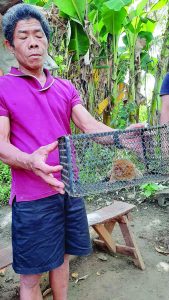TACLOBAN CITY – A Philippine tarsier locally known as “mago” was caught in Quinapondan town in Eastern Samar province by a farmer last Monday (Nov.13).

The tarsier was caught by Florencio Caandoy while he was collecting firewood in Barangay Palactad who immediately informed their office, Engr. Felix John Bianes, head of the municipal environment and natural resources, said.
Bianes said that this was not the first time that a tarsier was seen in the village as there were sightings of the said primate in the past.
Bianes then informed the regional office of the Department of Environment and Natural Resources (DENR) based in Tacloban City which dispatched a team to the town to look into the discovery of the tarsier.
The DENR personnel conducted an interview with Caandoy as they informed him that keeping a tarsier is illegal and punishable.
Caandoy, however, said that he had no intention to keep it to himself the said animal which was released back to the forest.
The DENR in the region has reiterated its appeal to the public not to keep any wildlife like the tarsier saying it’s punishable under RA 9147(Wildlife Resources Conservation and Protection Act)
Violators face imprisonment of up to four years and a fine of up to P300,000.
Earlier this week, a Philippine tarsier (tarsius syrichta) was seen and photographed in Almeria town in Biliran province.
The town’s information office said that the tarsier was seen on Nov. 11 in the forested area of Sitio Palayan, Brgy Caucab.
Last year, a sighting of tarsiers was documented in Tacloban City during the night survey conducted University of the Philippines Tacloban in Brgy. Sta Elena.
Tarsier is a primate that is endemic to the Philippines and commonly found particularly in the islands of Bohol, Samar, and Leyte, including Biliran and Maripipi islands.
Nocturnal in nature, its main diet includes insects like grasshoppers, crickets, spiders, small vertebrates such as small lizards and birds.
The Philippine tarsier is considered to be one of the smallest primates in the work whose ranges from 118 to 149 millimeters while its average weight is between 113 and 142 grams.(ROEL T.AMAZONA with ROBERT DEJON)



